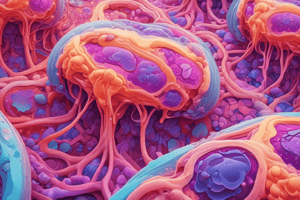Podcast
Questions and Answers
What is the most common cause of Acute Tubular Injury (ATI)?
What is the most common cause of Acute Tubular Injury (ATI)?
- Direct toxic injury: drugs, radio-contrast dyes, myoglobin, hemoglobin, and radiation
- Overwhelming sepsis or other causes of Multi-organ failure
- Ischemia: shock, dehydration, malignant hypertension (correct)
- Inflammation of the tubules and interstitium (tubulointerstitial nephritis)
Which part of the nephron is most affected in ischemic ATI?
Which part of the nephron is most affected in ischemic ATI?
- Distal convoluted tubule
- Proximal tubule straight segments (PST) and thick ascending loop of Henle (HL) (correct)
- Glomerulus
- Collecting duct
Which of the following is a characteristic of the recovery phase of ATI?
Which of the following is a characteristic of the recovery phase of ATI?
- Salt and water overload
- Oliguria (40-400 mL/day)
- Hyperkalemia
- Rising urine volumes (up to 3 L/day) with water, sodium, and especially potassium losses (hypokalemia) (correct)
Which of the following is a poor prognostic factor for ATI?
Which of the following is a poor prognostic factor for ATI?
Which of the following is a characteristic of nephrotoxic ATI?
Which of the following is a characteristic of nephrotoxic ATI?
How does hypertension affect the renal vasculature?
How does hypertension affect the renal vasculature?
What is the main cause of malignant nephrosclerosis?
What is the main cause of malignant nephrosclerosis?
What is the main feature of benign nephrosclerosis?
What is the main feature of benign nephrosclerosis?
What is the main structural change seen in nephrosclerosis?
What is the main structural change seen in nephrosclerosis?
What is the most common cause of malignant hypertension?
What is the most common cause of malignant hypertension?
What is the main feature of thrombotic microangiopathies?
What is the main feature of thrombotic microangiopathies?
What is the main cause of nephrosclerosis?
What is the main cause of nephrosclerosis?
What is the most common cause of acute renal failure in hospitalized patients?
What is the most common cause of acute renal failure in hospitalized patients?
Which disorder is characterized by renal calcium deposition and can lead to renal failure through tubular obstruction?
Which disorder is characterized by renal calcium deposition and can lead to renal failure through tubular obstruction?
What percentage of multiple myeloma patients have Bence Jones proteinuria?
What percentage of multiple myeloma patients have Bence Jones proteinuria?
Which of the following conditions has eosinophils and edema present in the interstitium?
Which of the following conditions has eosinophils and edema present in the interstitium?
In Light Chain Cast Nephropathy, what toxic effect contributes to renal insufficiency?
In Light Chain Cast Nephropathy, what toxic effect contributes to renal insufficiency?
Which condition is characterized by a T cell–mediated immune reaction to a drug causing interstitial inflammation in the kidney?
Which condition is characterized by a T cell–mediated immune reaction to a drug causing interstitial inflammation in the kidney?
Flashcards are hidden until you start studying




